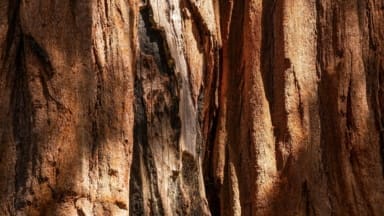
In awe of the Sequoiadendron giganteum, the Victorians are accredited to bringing so many seeds and seedlings from the US, that there now an estimated 500,000 in Britain. In the wild giant redwoods are unfortunately endangered, with fewer than 80,000 giant sequoias remaining in their native California.
Even though introduced to the UK 160 years ago, this is the first time the trees’ growth rate and resilience in the UK have been analysed. The research, which was funded by NERC National Centre for Earth Observation (NCEO) in conjunction with Royal Botanic Gardens Kew, aimed to improve the understanding of their growth capability in the UK and carbon storage potential.
Lead author Ross Holland, formerly a Master’s student at the UCL Department of Geography and now at East Point Geo, said: “Giant sequoias are some of the most massive organisms on Earth and in their native range make up some of the most carbon dense forests in the world due to their great age. We found that UK redwoods are well adapted to the UK and able to capture a large amount of carbon dioxide. We hope that these findings can help guide decisions on future tree planting and management.”
Giant redwoods can live for over 3,000 years. According to Kew, one of their secrets to their long life is that the tannin in their bark, boosts their resistance to pests and diseases. They can grow up to 90 metres tall, and whilst not at tall as the closely-related coastal redwood, their wide trunks grow out, giving them the greatest volumes. Reportedly, the tallest giant sequoia in the UK is found at Longleat in Wiltshire, measuring in at 57 metres. The biggest (tree) in the world is located in Sequoia National Park measures in at 84 metres. Known as General Sherman, the tree is estimated to be around 2000 years old.
Native to the California’s Sierra Nevada mountains, the researchers wanted to gauge how they fare under UK climates, which are milder and with a wider range of rainfall. The team visited Wakehurst, Havering Country Park in Essex, and Benmore Botanical Garden in Scotland. They found that the trees at Kew and Benmore grew at similar rates as their US counterparts, although growing slightly taller and slimmer at Benmore compared to Wakehurst, while at Havering the trees grew more slowly, likely due to less rainfall in the region and more competition from dense local woodland.
The tallest tree they found measured about 180 feet tall (54.87 metres) – giant compared with most native UK species, but dwarfed by their American counterparts. This is in part because of the UK sequoias’ youth: the oldest giant sequoias in the UK are those at Benmore, the earliest dating to 1863.
Senior author, Professor Mat Disney (UCL Geography), said: “These results give us an important baseline for estimating how well giant sequoias are doing in the UK climate. Currently, these trees are probably more important for their aesthetic and historical interest than they are for solving the climate crisis. But as more are planted we need to know how they will grow. The history of these trees in Britain is fascinating – initially as symbols of wealth and power, through to now being widely planted in parks and woodlands. They are iconic, but there is almost no work on how fast they grow or how well they will do in the UK’s changing climate. I find it amazing to see these giants dotted across the landscape and see how rapidly they are growing.”
The giant redwood can potentially pull an average of 85 kilograms of carbon out of the atmosphere per year. However, even though the giant sequoia stack up well for sequestering carbon, the researchers caution that planting trees requires long-term commitment, and consideration needs to be given to how well they will thrive in the UK’s changing climate in the next 160 years and beyond.

